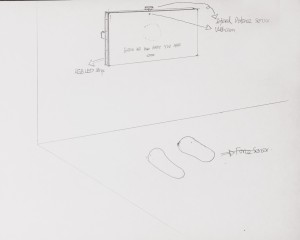Yan Zhao
Happy Spotify Mirror is a smart mirror that can be triggered by smile to play spotify music and light up. The idea of this project is to break the traditional way of how to play online music and explore a different way of interaction between people and computer.
http://yanzpro.com/happyspotify
Description
Happy Spotify Mirror is an experiment of exploring new interaction methods between people and computer.It will be displayed as a one-way through mirror with a monitor hidden at the back. At the first glance, it looks the same as a normal mirror. The special about it is it is an interactive mirror with music, graphic effect and lighting. It can play spotify music but is differ from the traditional way of playing online music; instead of screen interface, spotify app, or physical button, there is only a mirror for interaction. The only way to trigger it is to stand inside of specific distance and then smile to the mirror and hold the smile for seconds, then the music will be triggered, at the same time on the mirror will appear interesting graphics synching with the music. Lighting effect synching with the music will also happen around the mirror. If you want to change the music, go back to straight face and then smile again, you will change it to play another music. . If you keep the same smile after the music is triggered, you will see different colorful graphic effects. If you have different levels of smile, different music played by different instruments will be triggered. For example, if you are little happy, it is piano, if you are happier, it is ukulele. If you are very happy, it will be violin. Also when you change the distance from the mirror, you will change the volume of the music. For example, if you move towards the mirror, the volume will be louder, vice versa. In conclusion, the Happy Spotify Mirror is experimenting on making the interaction between people and computer much more interesting, natural and minimizing the perceptible invasiveness of computer.
Classes
Introduction to Computational Media, Introduction to Physical Computing

